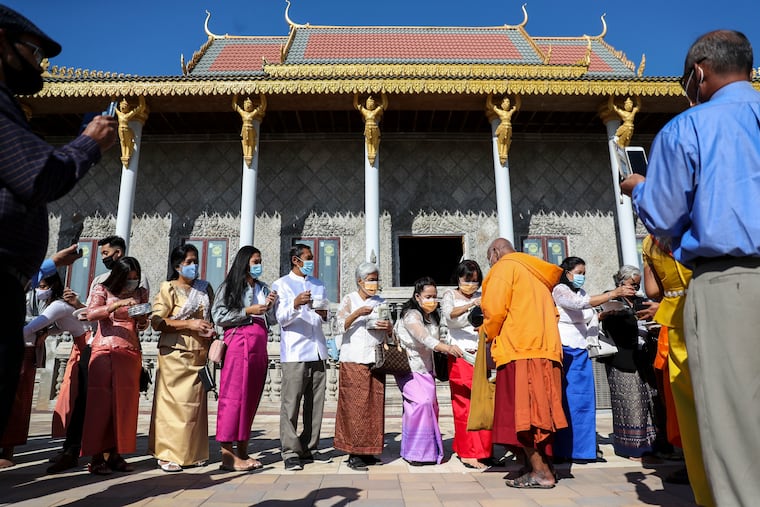Here’s where to celebrate the Cambodian New Year in Philly
The Khmer New Year falls on April 13, 14, and 15 this year, but the community in diaspora celebrates all month long.

As a child, Sarun Chan was always mesmerized by the sights when he would walk into his Buddhist temple for the Cambodian New Year.
Hundreds of people would set up their meal offerings for the monks, each family walking into the temple carrying a traditional metal container (chan srak) with elaborate designs etched on it that held the dish they made for the occasion. Hundreds of bowls and plates filled with Cambodian red curry, glass noodles, stir-fries, and other traditional dishes would be placed in front of the monks, who would then pray and chant mantras before consuming the food.
“It’s the hundreds of people bringing all this food that was always really potent,” Chan, executive director of the Cambodian Association of Greater Philadelphia, recalled. Chan’s foot falling asleep from sitting in the temple for so long was also a powerful memory, he added.
The Cambodian New Year, or Khmer New Year, falls on April 13, 14, and 15 this year. While the celebration traditionally spans three days, in the Philadelphia region, the celebrations often take place the whole month as community members hold on to tradition and each other.
What is the Khmer New Year?
In Buddhism, the marking of a new solar year commemorates a new moon rising and angels falling into one’s home to bless it for the year. The holiday often falls on the same dates, and each day holds a different significance and celebration.
The first day is traditionally celebrated with families gathering at their homes to prepare their offering tables for when the angel arrives. Offering tables may hold everything from fresh fruit and home-cooked meals to incense and flowers.
“Just being able to travel and see other Cambodians from our diaspora is very inspiring.”
“It’s like a passage for the angels to enter your home,” said Ayana Chhoeun, lead case manager at CAGP.
The second day is celebrated in the temple, where families bring their offerings for the monks and call on their ancestors’ spirits to join them for the festivities. Red strings are passed around for people to tie around their wrists for protection and blessings throughout the entire year.
The final day is spent blessing the elders. Young family members will wash elders’ feet and faces with blessing water from the temple to pay their respects and receive blessings in return.
How is the New Year celebrated?
When Chan was younger, he and his family used to travel to Silver Spring, Md., to visit one of the first Buddhist pagodas built in the U.S.
“Just being able to travel and see other Cambodians from our diaspora is very inspiring,” Chan said.
While Chan’s family stopped going to Maryland after a pagoda was built in Philadelphia, it is a common practice for families to travel to various Buddhist temples for the holiday.
“We have over eight different types of temples now in the tristate area,” Chan said. “Now, people are able to feel that sense of pride and have their own local spaces to visit, because when we first arrived in America, we didn’t have access to that.”
In addition to the traditional celebrations brought from their home country, the Cambodian diaspora has established local traditions in the U.S. In Philadelphia, it became common for communities to shut down streets to throw block parties for the New Year, with live bands, dancing, and of course, plenty of Cambodian food.
On the weekends, temples across the region take turns throwing parties. During the festivities, and as a way to keep children more engaged after long ceremonies, kids run around throwing baby powder or shaving cream at each other. It is a sight Chan likened to the colorful celebrations of the Indian holiday Holi. While the act is fun, Chan said it signifies blessing each other’s friends.
The celebrations last all month for Cambodian Americans, Chan and Chhoeun said, because of the frequent festivities and activities, but also so that people who do not live near temples are able to travel to the celebrations over the weekends.
“This was something [my grandparents] wanted to keep with them, especially now that they have their children, grandchildren, and now great-grandchildren,” Chhoeun said. “They raised us to keep our culture very, very close to our hearts.”